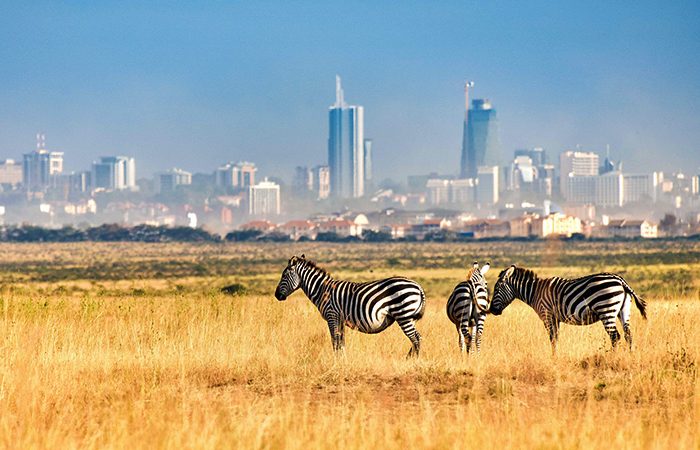Popular National Parks
Nairobi National Park
Region:
Nairobi City
Nairobi National Park was established in 1945 and is Kenya’s first and oldest
national park. Uniquely situated on the capital’s doorstep it is a well-kept piece of wilderness hosting a large number of Africa’s best-known animals. Large herds of zebra, wildebeest, buffalo, and giraffe roam the plains, and black rhino, ostrich, baboons, cheetah, and lions are some of the other photogenic species.
Significantly absent from Nairobi Park is the African elephant.
Nairobi is a very strategic park for quick safaris and the only park in the world
where you can take pictures of rhinos and lions with city background. There are also numerous campsites ideal for family outings and picnics. At the park’s gate is the Nairobi Safari Walk. It showcases Kenya’s different ecosystems and representative animal species and offers visitors a chance for a leisurely walk and learning. The Animal Orphanage, also at the park entrance, is where sick, wounded and abandoned animals are cared for and rehabilitated.
See Nairobi City Tours for more details.
Close by is the Sheldrick Elephant Orphanage, where infant and orphaned elephants and rhinos are cared for and eventually returned to the wild – mostly in the Tsavo National Park. The center is open every morning at 11 am and visitors can watch the calves bathing in the mud hole and being bottle-fed by their human surrogate mothers.
Contact us for accommodation in Nairobi Park and adjacent areas

Amboseli National Park
Region:
Southern Kenya
Amboseli is world renowned for large herds of elephants presided over by the magnificent backdrop of Africa’s highest mountain, Mt Kilimanjaro. One of Africa’s most iconic images from Amboseli is a picture of a herd of elephants before the gigantic snow-covered mountain just over the border in neighboring Tanzania. It is a relatively small park with wide plains merging with the distant skyline, affording good visibility in all directions.
Nomatior Observation Hill rises from the center for breathtaking views over the park and towards Mt Kilimanjaro, especially in the pink light of dawn. Meaning ‘Place of Water’ in the Maasai language, it has a continuous supply from Kilimanjaro’s snowmelt, forming underground springs that feed the marshy patches and swamps home to hippos and a great variety of bird life. Predators are relatively scarce apart from jackal and hyena, but a good game drive should accord a chance to see lions too.
There are large numbers of grazing animals like buffalo, wildebeest, zebra and gazelles on the grassy plains and giraffe among the thorn trees.
The park has a permanent swamp which becomes the critical lifeline for animals in the park including the livestock from the surrounding areas during extreme dry periods. The swamp grows into a lake during the wet seasons which hosts numerous birds like pelicans and flamingos.
Mount Kenya National Park
Region:
Central Kenya
This national park encompasses Africa’s second highest mountain, Mt Kenya, an extinct volcano with a series of jagged snow-covered peaks. The local Kikuyu people revere the mountain they call Kirinvaga or ‘Place of Light’ as the home of their Supreme Being, Ngai, and traditionally Kikuyu homes are built to face the sacred summit.
Part of the mountain’s attraction is the incredible variation in flora and fauna due to the changes in altitude and its position on the equator. It’s a UNESCO classified World Heritage Site and one of the main sources of surface water for the country estimated to support a third of Kenya’s population. The slopes are covered in thick forest, home to a variety of animals including the black leopard, bongo, the forest elephant etc. Bamboo, moorland and alpine vegetation give way to rock, ice, and one of the world’s rarest sights – equatorial snow. The summit is a technical climb, but Point Lenana is a popular trekker’s objective, the third highest peak that can be reached by a number of different scenic routes, lasting from three to five days.
See mountain climbing for possible itineraries or contact us for details
Maasai Mara National Reserve
Region:
South Rift Valley
Maasai Mara was voted by WWF in 2006 among the top ten travel destinations in the world and continues to be ranked as the leading safari destination in Africa. It was voted by America’s ABC Television as the 8th Wonder of the World in 2007.
Kenya’s most visited park, commonly known as the Mara, is a wildly beautiful place with rolling savannah grasslands and is an extension of the Serengeti Plains in neighboring Tanzania. Much of the film ‘Out of Africa’ was filmed here and it offers wonderful views and an extraordinary concentration of wildlife, including the ‘Big Five’.
It has the largest population of lion, was the filming site for BBC Wild Cat Diary.
The large herds of grazers also attract many other predators such as cheetah and hyena. The annual highlight is the Great Wildebeest Migration, creating one of the world’s supreme natural spectacles, when an estimated two million animals form one large herd and leave the dry plains of Tanzania to seek greener pastures in the north, arriving in the Mara from late June onwards and returning again in September. Their entrance into the Mara makes a breathtaking spectacle, as they cross the crocodile-infested waters of the Mara River.
A once-in-a-lifetime way to experience the magic of African dawn over such a wilderness is by hot air balloon, drifting silently over the herds below.
Maasai Mara is incomplete without the adjoining community conservancies that extend the wildlife range in return for income from tourism and livestock.
See Wildlife Conservancies
Tsavo National Park
Region:
The Coast
The vast Tsavo National Park is only an hour’s drive from Mombasa along the main highway to Nairobi, and for administrative purposes is divided into the East and West. Covering 8,422 sq miles (21,812 sq km), the park is home to giraffes, buffalo, antelopes, monkeys, many exotic birds, and Kenya’s largest herds of elephants. The elephant often looks startlingly red, covered in the dust and mud of the region’s ruddy soil. Visitors are also likely to see rhinos, both in natural populations and also at the Ngulia Rhino Sanctuary in Tsavo West.
Tsavo has the largest elephant population in Kenya, estimated at over 10,000 currently. It’s a place of great sceneries and geological features like Luggards Falls, Aruba Dam, Mzima Springs and Shetani Lava among numerous breathtaking attractions.
Lake Nakuru National Park
Region:
Central Rift Valley
Although tiny by the standards of African national parks, Lake Nakuru has huge concentrations of game where you can easily see the big five except elephants. It is one of Kenya’s important rhino sanctuaries and has a good population of white rhinos and black rhinos which are easily seen on a good (and lucky for black) game drive. There are also several prides of lion and it is one of the best places to spot leopards perching on the acacia woodlands. Other unique mammals include the Rothschild Giraffe, for which the park serves as the main sanctuary.
Historically, the park is more popular as a bird sanctuary and was the first in Africa to be conserved expressly for bird conservation.
The surface of the shallow alkaline lake covers about a third of the park and the saline concentration supports a blue-green algae that attracts thousands of flamingos. This pulsating pink carpet covering the fringes of the lake is a breathtaking sight and at any disturbance, the air above becomes a noisy confusion of long pink legs and reddish wings in flight. Large flocks of pelicans are also attracted to the rich food source in the lake, especially at river mouths where waters host large fish populations. Waterbucks, reedbucks, buffalo and hyenas are common sights along the shores. The park has several high points with good lookouts and waterfalls. The most popular is the Baboon Cliff lookout and the Makalia Falls, from where visitors mingle with monkeys, baboons and rock hyraxes.
Lake Nakuru has often been described as the “biggest ornithological site on earth” and is an important Ramsar Site in East Africa as well as an Important Bird Area.
Lake Nakuru’s geography and ecology has undergone changes in the last few years after steep rise in water levels. This has seen a remarkable drop in flamingo population. The famous pink shoreline has been disrupted and its not clear when ecological status quo will come back.
Contact us for more details
Hell's Gate National Park
Region:
The Great Rift Valley
This is perhaps the most scenic park in Kenya.
Named for the pair of massive red cliffs of the Njorowa Gorge that encloses a geothermic area of hot springs and steam vents, Hell’s Gate is one of the two parks in Kenya that allows visitors to explore on foot, making it an ideal place for hiking, cycling, camping and rock climbing.
The sheltered cliffs provide safe breeding grounds for eagles and vultures and the park has been a breeding sanctuary for Lammergeier vulture.
The open plains host several mammal species such as zebra, buffalo, eland, gazelle and hartebeest and the experience of walking alongside a giraffe or past a herd of zebra is a memorable one. However, it’s always important to emphasise that Hells Gate is more a scenery park than a wildlife park.
The towering cliffs, rock towers and volcanoes have given a backdrop for films such as King Solomon’s Mines, Magambo, Born Free, Queen of the Jungle etc
A walk at the gorge is a great hiking challenge and experience as well as the geothermal spa formed from natural hot steam.
Shimba Hills
Region:
Coast
Shimba Hills is a rolling country, open grasslands with stands of coastal rainforest. Higher than the coast, it is cooler and offers a panoramic view of the Indian Ocean to the East and Tanzania’s Usambara and Pares mountains in the south-west.
It has the last breeding herd of sable antelopes in Kenya, with an exceptional bird viewing with spectacular concentration of Palearctic migrants. Another unique feature is the Sheldrick’s Falls and vegetation constitutes of a wide variety of rare orchids and cycads.
Meru National Park
Region: Eastern Kenya
Meru is a great landscape dominated by savannah with rocky outcrops, acacia woodland, and combretum bushes. A dense riverine forest along the banks of three main rivers gives the park unique scenery.
It was once home of the famous ‘Elsa’ (the lioness in Joy Adamson’s book Born Free). Popularly known as ‘Elsa’s country’, Meru National Park is a designated wilderness area that’s great for walking and viewing the northern species of game such as Beisa Oryx and Zebra Grevy’s. The park is somewhat off the beaten track – perfect for those looking for something a little different.
Samburu and Buffalo Springs
Region: Northern Kenya
These are the most easily accessible of northern Kenya’s game sanctuaries. The Ewaso Nyiro River (meaning ‘muddy waters’ in the local Samburu language) with its ochre sandbank lined with whispering doum palms gives the reserve a distinct beauty especially during the dry season when all animals congregate along the river in search of water.
Also of distinction and interest here are the northern range species. Leading in this category are Reticulated Giraffe, Somali ostrich, Beisa Oryx, Grevy’s Zebra and the long-necked antelope, Gerenuk.
Samburu also has large population of elephants and hippos while the river is always teeming with crocodiles.
